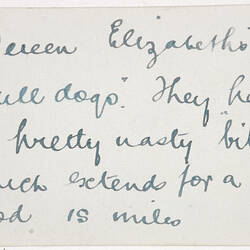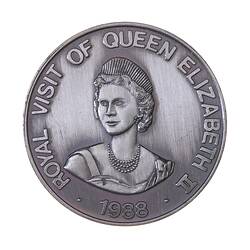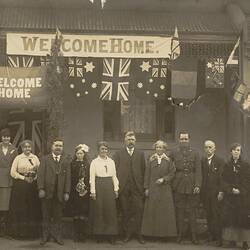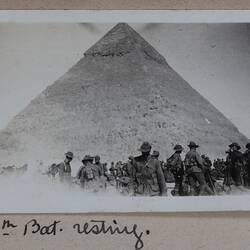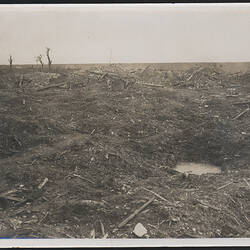Summary
Black and white photographic print depicting a Queen Elizabeth Class British Monitor, referred to in the inscription as 'Queen Elizabeth's Bull Dogs'. There were five Queen Elizabeth battleships in total, the lead being named after Queen Elizabeth I of England and launched in 1913. The other battleships in this class were the H.M.S Warspite, Valiant, Barham and Malaya. The Queen Elizabeth Class had superior speed and firepower to her German counterparts and is considered be to the first of the fast battleships.
Attached to a small notebook used as a photograph album, containing 55 black and white photographs of ANZAC soldiers in Egypt, Mudros and Gallipoli during World War I. The photographs were taken by an Australian soldier, Sergeant John Lord or a fellow soldier (to be verified). John Lord served in the 13th Field Ambulance and returned to Australia shortly after the end of the War in 1919.
The album was one of many souvenirs brought back to Australia after World War I by Lord. Part of a larger collection of photograph albums, images, documents and World War I memorabilia donated by John Lord to Museum Victoria.
Description of Content
What appears to be the mid-section of a warship (due to presence of weapons on deck). There are figures in the foreground, with their backs to the camera, who appear to be on a different vessel looking across at the ship depicted.
Physical Description
Black and white photograph, mounted in a small, blue, army-issued notebook used as a photograph album.
Significance
This photograph is in a very significant album which includes a number of excellent photographs of Australian soldiers at Gallipoli and surrounding areas. Some of these are particularly clear and well-composed - for example, 'Rest Gully Anzac' shows hundreds of soldiers sitting and standing around talking and a valley with lots of dugouts and shelters. 'Old Kit etc at Anzac Ordnance Stores 1915' is another clear photograph, ,showing rubbish that the Anzacs generated at Gallipoli. Many of the photographs were taken when the weather was hot, but there are also a number of images taken in the snow. Another, 'Extreme Right of Anzac' demonstrates the steepness of the terrain and the mixture of clothing that the soldiers wore. All of the photographs appear to have been taken at times when the photographer was 'off duty', since the images are of the landscape or soldiers at rest.
More Information
-
Collection Names
Military Memorabilia Collection, John Lord Collection, Returned and Services League (RSL) Collection
-
Collecting Areas
-
Acquisition Information
Donation from J. Lord, 24 Feb 1986
-
Place & Date Depicted
-
Previous Owner
Sergeant John Lord - Australian Imperial Force (AIF)
Private John Lord was originally identified as the photographer of the album, but as there is no record of him serving on Gallipoli, and images in the album depict Gallipoli, the photographer is probably an unknown soldier. -
Format
Photograph, Black & White
-
Inscriptions
Hand written in pencil directly below image: 'British / Monitor.' Hand written in ink on verso: 'Queen Elizabeth's / "bull dogs". They have / a pretty nasty "bite" / which extends for a / good 15 miles'.
-
Classification
-
Category
-
Discipline
-
Type of item
-
Image Dimensions - Photograph
45 mm (Width), 65 mm (Height)
-
Image Dimensions - Photograph album page
145 mm (Width), 100 mm (Height)
-
Keywords
Australian Army, Militaria: Australian, Military Memorabilia, Wars & Conflicts, World War I, 1914-1918

